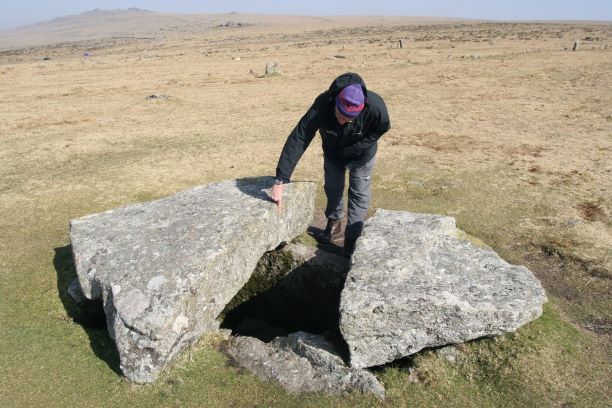Question 4: Who was buried in the cist at Merrivale?
Ancient Burials
Show the students the photograph of the cist (Resource 7) at Merrivale and remind them that only two such burial chambers have been found among the monuments.

This is by far the larger of the two measuring over two meters long and 1.5 meters in depth and still has most of its capstone. No one knows who was buried in it or why but it would have taken a large group of people many days to dig and line and cap with granite. Whoever was buried within it would clearly have been very important but no evidence of who they were or what they did remain. This is because the soil at Merrivale on Dartmoor in Devon is peat-based and acidic which means organic material of any kind in the ground decays away very quickly. The cap-stone was split by a farmer or landowner in the 19th Century, before the value of the monument was recognised, and the marks that were made during this splitting process are being pointed at.
During the Bronze Age it was common practice to bury deceased high status women and men (either their body in a foetal position or cremated remains in an urn) in individual stone lined graves or cists in special ceremonial places such as Merrivale. Burials were accompanied with the laying down of grave goods including food, drinking vessels and body ornamentation.
In richer burials, gold sheet work was attached to clothing, and later still pins, tweezers, and razors were found. Wealthy and ‘elite’ women in death might wear fine jewellery, while men were laid out with their weapons, be they finely knapped arrowheads early in the period, or bronze daggers in a later period. The fact that so many bodies were laid out with food and drinking vessels seems to suggest that our Bronze Age ancestors believed in some form of life after death at least, and that not only were the dead thought to be capable of enjoying their grave goods, but that the afterlife required tools and utensils very similar to those used when they were alive.
The Warrior Chief
Now ask the students to consider the large empty cist at Merrivale and to imagine that 4000 years ago it was prepared to take the body of a very famous warrior chief. Imagine that he had lived to over 50 years which was incredible for that time and all of the people in the area admired and respected him for what he had achieved on their behalf. He would have certainly been a capable warrior but would have also overseen the setting up of all of the local settlements in which people lived and farmed as well as negotiating trade deals with other Bronze Age communities across the south west. Above all he would have been responsible for maintaining peace and a stable life for everyone much like we look to our elected politicians and Prime Minister to do for us today.
We know that he would have most likely have been buried (inhumation) because of the size of the grave. Encourage the students to think what mourners from communities near and far might have buried with him as a tribute to his great achievements on earth and also for him to use again in the afterlife.
Together they must agree only ten things to place in the cist with the warrior chief. What should they be? Encourage the students to look at the goods discovered in the graves of the most important Bronze Age burials so far discovered in Britain.
After agreeing which artefacts should become grave goods the students could draw and label the inside of the grave to show the body on its side in a foetal position surrounded by each of the named items.
Summary
To conclude this scheme of work ask students to watch this YouTube film:
